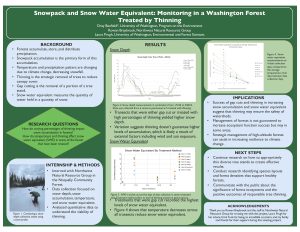Snowpack and Snow Water Equivalent: Monitoring in a Washington Forest Treated By Thinning
Forests play a significant role in the water system, storing and distributing water through snowpack accumulation. Changing climate conditions are shifting temperature and precipitation levels, effectively reducing precipitation by snowfall in recent years, resulting in an increased need to find strategies to support adequate snowpack accumulation in forest ecosystems. The aim of this study was to assess the effectiveness of forest thinning in increasing snowpack accumulation and snow water equivalent. To conduct this research, I completed onsite data collection, including snow depth measurements, temperature monitoring, and snow coring, at the Nisqually Community Forest in Ashford, Washington. The resulting data was synthesized to assess trends regarding temperature and thinning treatments’ effects on snowpack and snow water equivalent. Findings show transects with gap cuts or high percentages of thinning allowed for higher levels of snowpack accumulation and snow water equivalent. This suggests that forest thinning can increase snowpack accumulation and snow water equivalent and could be a viable strategy to improve the resilience of the Nisqually Community Forest and other similar Northwestern forests.
